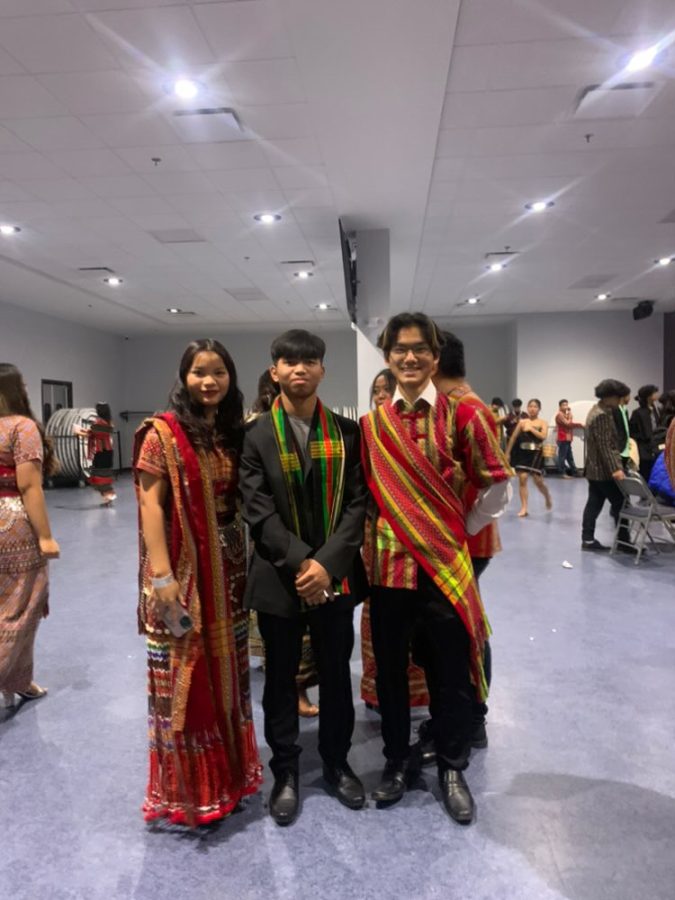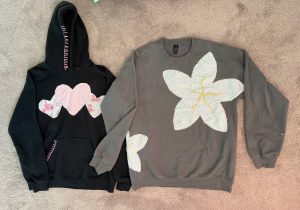Celebrating Chin culture
Students participate in Chin National Day festivities
Junior Cherry Iang, Chan Kung and junior Chan Thang pose for a photo wearing traditional Chin clothing during CEBC’s Chin National Day celebration on Feb. 18.
February 20, 2023
On Saturday, at Chin Evangelical Baptist Church on Meridian St., members of the Chin community of southside Indianapolis commemorated Chin National Day, the largest celebration for Chin people in the United States.
“Chin National Day is celebrated on the Saturday closest to Feb. 20 every year,” junior Vanlal Chhalthleng said. “Cultural groups from all sorts of tribes and communities are brought in this occasion to celebrate the achievements and liberty and promote bonds and mutual understanding with the communities.”
Although the holiday is typically celebrated in churches, it originates from politics. According to the Unrepresented Nations and Peoples Organization, the first Chin National Day was celebrated in 1948 to commemorate the adoption of democracy in Chin State, Myanmar, located in Southeast Asia where the Chin population is from.
Over time, however, it has come to represent all aspects of Chin culture.
“It’s a cultural holiday, but we do like to represent our religions that way too so it’s more of a mix,” junior Cherry Iang said. “It’s important because it teaches about community and the union because it was celebrated for the independence of the Chin people. I don’t know that much about the history, I just know how we celebrate it. It’s just more about Chin pride.”
Although Chin National Day finds its roots in democracy, the Myanmar government was overthrown in a coup in 2021, leaving the nation under military rule. Many Chin families, including those of Chhalthleng and junior Chan Thang, were drawn to the southside of Indianapolis, one of the largest Chin communities in the country, to flee religious and ethnic persecution.
“The reason why we moved from Burma was because of the government and the military,” Thang said. “Especially right now, there’s a military coup happening. We still haven’t been able to have independence. The main religions there are Buddhism and Hinduism, but most Chin people believe in Christianity. We don’t have freedom of religion or freedom of speech or anything like that. We can’t even go out by ourselves without fearing for our lives.”
Today, over 30,000 Chin people call the southside of Indianapolis home, according to Chin Community of Indiana, a group that helped organize this year’s Chin National Day celebrations. Within the Chin population there are 53 tribes, each with their own characteristics and customs.
“There’s many types of Chin people,” Iang said. “There’s Kachin, Haka, Mizo, Zomi – a lot of Chin tribes. They may be similar, but they’re different in other ways.”
One such difference is language; different Chin tribes have their own. While some dialects are similar, Zophei and Mizo, for example, are vastly different.
“All together, we’re all called Chin,” Thang said. “Even though there’s different languages, it is to a point where we can still communicate with each other. Even though we don’t know their language, or how to speak it, it sounds similar to certain dialects. We can use common sense to figure out what they’re saying. We all have a basic language that we all have to learn, Hakha, which is the main Chin language in Burma. So most people from the country know how to speak Hakha at least.”
Additionally, the tribes have unique flags, dances and clothing that distinguish them from other Chin people. But on Chin National Day, they choose to emphasize what they have in common.
“One thing that we all have in common is bamboo sticks,” Thang said.
Those bamboo sticks are used for a dance, which Chin people are taught growing up. It requires bending down, hand movements and precise stepping. Although the dances can vary from tribe to tribe, they take pride in performing on Chin National Day.
“The guys will do the bamboo – hit it – and the girls will do specific patterns and rhythms,” Chhalthleng said. “The girls do different sorts of dancing. You’ve got to be in sync and you have to have good timing or you’re going to get hit. Bamboo sticks hurt.”
The day’s festivities also include eating traditional foods, mainly consisting of meat, such as voksa, made of pork belly, and chowsa, beef. To accompany the dancing, Chin singers from around the world perform, as well.
“We got singers from India, which is where most Mizo people are from, which is what I am,” Chhalthleng said. “There’s cultural differences, they do exist, but within the cultural dances, there are like 10 cultural dances that each show what the culture overall is about and what they do.”
By exercising their rights to freedom of religion in the United States, the CEBC hopes to support the Chin population in Myanmar.
“I know that during Chin National Day, especially when the government is harming the people of Burma, we are using it as a way to spread awareness about what they have been doing,” Iang said. “My church, the CEBC, is donating money, clothes and everything to Burma right now, and we’re using Chin National Day as a donation box for that.”
Whether it is through holding fashion shows with traditional clothing, hosting musical artists from around the world or raising donations for the persecuted, Chin National Day has one clear goal – to champion the uniquely Chin message of diversity and unity.
“The Chin community is a very interesting community,” Chhalthleng said. “You can learn about the diversity, their different backgrounds. Chin people are really easy-going, calm people.”
“For someone who doesn’t know about Chin National Day, I would just want to educate them about it,” Iang said. “They don’t have to celebrate it or anything, but we accept other people to our community, so I would like them to try it out and see what happens.”
Finn Nowacki contributed to this article
















